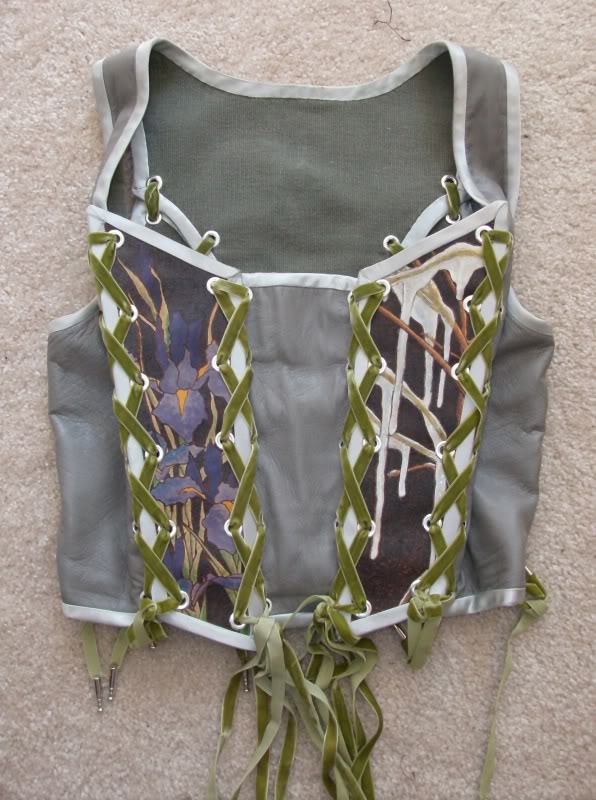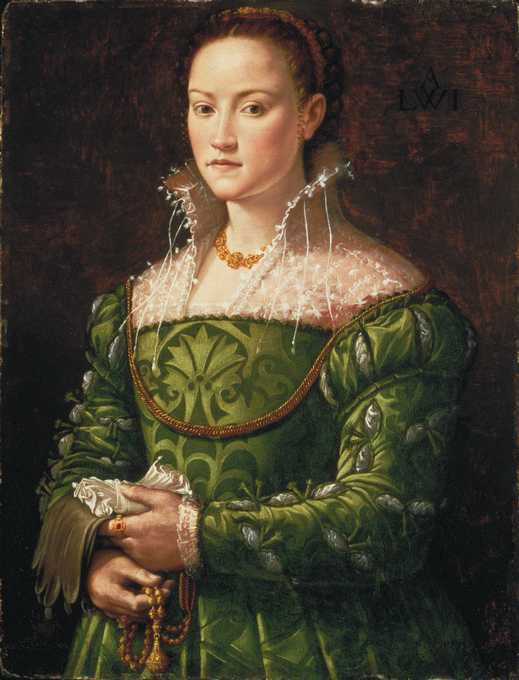Bodice

A bodice is an article of clothing for women, covering the body from the neck to the waist. The term comes from pair of bodies (because the garment was originally made in two pieces that fastened together, frequently by lacing). In common usage, bodice refers to an upper garment that has removable sleeves or no sleeves, often low-cut, worn in Europe from the sixteenth century to the eighteenth century, either over a corset or in lieu of one. To achieve a fashionable shape and support the bust, the bodice was frequently stiffened with bents (a type of reed), or whalebone. The bodice was also different from the corset of the time because of the way it laced. The corset was laced in spiral fashion, with one continuous lace. The bodice was laced like the modern tennis shoe, with eyelets facing one another. This was more convenient for women who had to dress themselves.
Bodice continues in use to refer to the upper portion of a one- or two-piece dress to distinguish it from the skirt and sleeves. The bodice of a dress was called the corsage in the nineteenth century.
The style of bodice worn by most re enactors is actually copied form the styles of the lower class, although typically created in more sumptuous fabrics.
History of Bodice Wear, Thanks Elizabeth
Until the mid 1550s in England the fashion remained for women to wear narrow-shouldered dresses with sleeves that widened to a trumpet form, a vestige of a medieval fashion. Towards the end of the 16th century, however, with the reign of Queen Elizabeth I, this fashion gave way to narrower, more form-fitting, sleeves and high, padded shoulders in the French and Spanish style. The reign of Queen Elizabeth would be accentuated by the display of style that she herself embodied. She would become the namesake and emblem of the Elizabethan era, her long reign as regent allowing for great cultural achievements as well as political change in England.
As a woman succeeding to the throne some eleven years after the reign of her father, Henry VIII, Queen Elizabeth had to cultivate an image of power and stability that could overcome perceptions of weakness in a female monarch without heirs. She soon established her persona as that of a virgin queen of almost mythic proportions, married to her subjects, and as her reign progressed would come to inhabit the role of regent supreme with great flare and pageantry. As portraits depicting her throughout the later years of her reign show, her image was elaborately devised for public reception. She was typically portrayed with her iconic red hair (often a wig), her slight body encapsulated by the extravagant lace collars and sleeves of her bodice and her frame further enhanced in its regality by the wide farthingales, or hooped skirts, that had risen from Spanish fashions.
The images of her became exemplary of the popular fashion of the time but with a level of glorification suited to a figure ordained by God, as she herself saw her role and responsibility as monarch. Typical of dress worn by women of the period, the upper arms of the garment would billow out and narrow towards the wrist and often would be decorated with slashings that allowed the underdress, or chemise top, to show through the surface textile. Women would wear form-fitting bodices that defined the waist and ended in a V-like shape, while lace accessories were often used to adorn the edge of the bodice at the chest and were also made as sleeve coverings.
The Spanish farthingale worn in England towards the end of the 1500’s had a conical shape and when paired with the corseted bodice would complete the image of a thin-waisted and composed woman, literally confined by the contraptions of her costume. The hoops of the farthingale were typically made of wood, rope, or eventually whalebone, as the skirts became wider and heavier. More than any other shape in the costume of the time, the wide, ribbed skirts were expressive of the nobility’s desire to be seen as formidable and simultaneously exquisite in their hierarchy. Queen Elizabeth’s portraits remark on how effective costume such as this could be in furthering notions of power and prestige.
